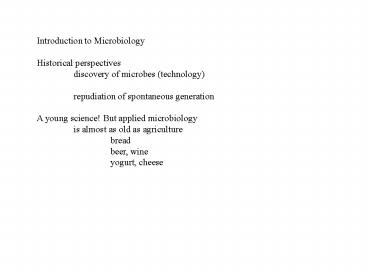Introduction to Microbiology - PowerPoint PPT Presentation
Introduction to Microbiology
Late 19th century (summarized on p. 4) Pure culture techniques. discovery of causative agents of disease. Control of infection with aseptic technique ... – PowerPoint PPT presentation
Title: Introduction to Microbiology
1
Introduction to Microbiology Historical
perspectives discovery of microbes
(technology) repudiation of spontaneous
generation A young science! But applied
microbiology is almost as old as
agriculture bread beer, wine yogurt, cheese
2
Pasteurs definitive experiment
Fortunately, no endospores were present
3
Late 19th century (summarized on p. 4) Pure
culture techniques discovery of causative agents
of disease Control of infection with aseptic
technique Staining techniques Discovery of
viruses Beginning to understand the immune system
4
Early 20th century Antimicrobials Genetic
exchange between bacteria (transformation) Eluci
dation of DNA as heritable material Vaccines (it
began with smallpox)
5
Late 20th century Biotechnology restriction
endonucleases?recombinant DNA technology genetic
engineering genomics Viroids,
prions Eradication of smallpox polio?
6
Infectious disease emerging diseases resurgent
diseases chronic disease autoimmune disease?
7
Microbes and the environment Unique metabolic
processes Nutrient cycling
8
Microbes (especially bacteria) as
model organisms Easy to grow Dont take up
much room Easy to manipulate Many processes
can be extrapolated to larger organisms
PowerShow.com is a leading presentation sharing website. It has millions of presentations already uploaded and available with 1,000s more being uploaded by its users every day. Whatever your area of interest, here you’ll be able to find and view presentations you’ll love and possibly download. And, best of all, it is completely free and easy to use.
You might even have a presentation you’d like to share with others. If so, just upload it to PowerShow.com. We’ll convert it to an HTML5 slideshow that includes all the media types you’ve already added: audio, video, music, pictures, animations and transition effects. Then you can share it with your target audience as well as PowerShow.com’s millions of monthly visitors. And, again, it’s all free.
About the Developers
PowerShow.com is brought to you by CrystalGraphics, the award-winning developer and market-leading publisher of rich-media enhancement products for presentations. Our product offerings include millions of PowerPoint templates, diagrams, animated 3D characters and more.








![[PDF]❤️Download ⚡️ Microbiology: Clinical Microbiology Made Easy: An Introduction and PowerPoint PPT Presentation](https://s3.amazonaws.com/images.powershow.com/10076449.th0.jpg?_=20240710114)

![PDF Fundamentals of Microbiology: In-depth Introduction and Practical Guide [Print Replica] Kindle Edition Full PowerPoint PPT Presentation](https://s3.amazonaws.com/images.powershow.com/10077863.th0.jpg?_=20240712084)




















